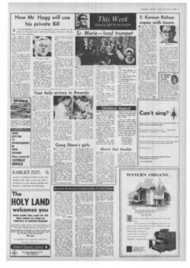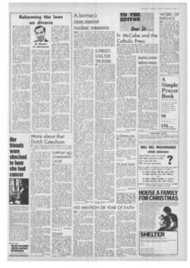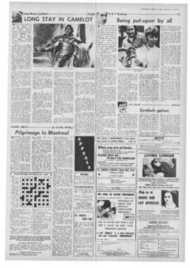Page 7, 24th November 1967
Page 7

Report an error
Noticed an error on this page?If you've noticed an error in this article please click here to report it.
Tags
Share
Related articles
Foundations Of Culture
Loving What You Don't Believe In
;iit Pou Twill) Want To &mk In The
Keeping All The Children (and Most Parents) Happy
These Are For* 4 C
Fairy tales, folk tales and stories by the bundle
FAIRY TALES are overproduced, but, as with picture books, you can hardly have too many of the good ones or too few of the really terrible bad ones.
1 recommend Andrew Lang, who never dates or palls, illustrated by Margery Gill, of whom I can say much the same; More Favourite Fairy Tales is taken from his Colour Fairy Books and makes one of the expensive but handsome Nonesuch Cygnets (35s.). Perrault is well served in a dashing new translation by Anne Carter illustrated with tremendous verve by Janusz Grabianski — Perrault's Fairy Tales (Cape, 3(s.).
Virginia Haviland. an American. tells Favourite Fairy Tales in a Bodley Head series at 16s.; of the eight so far I've got and thoroughly enjoyed Told in Nor • wsl, Ireland, France and Russia. Edith linnerstad is a Swede who writes about trolls rather than fairies in Twilight Tales (M ichael Joseph, 21s.), as well as modern children. Kathleen Hunt's The Midsummer Acorn (Bodley Head 9s. 6d.), tells three traditional fairy tales with the right bloom of magic and simplicity.
And as an example of the really horrific, there's The Fairy Tale Treasury in Living Colour (Purcell, 30s.), which isn't credited with anything as plain as an author but is "the first book in Great Britain with a three-dimensional full colour illustration". And let's hope the last. You'd have to go a very long way to see a more hideous set of whimsical puppets than those used to make its illustrations.
Folk tales are full of fairytate elements and you can't separate the two. Natalie Duddington's Russian Folk Tales (Hart Davis. 21s.), translated from Afanasyev, who first wrote 'them down in the middle of the last century, is full of Russian magic as well as Russian realism and Dick Hart's surprisingly charming pictures (as a rule he goes in for the plainly hideous) catch elements of both. Mrs. Duddington is Russian by birth and has kept the right flavour of old Russianness about them. Jennifer Westwood's Medieval Tales (Hart Davis. 21s.) are all taken from French and British sources and make a pleasant bunch of romances, moral tales, love stories and magical stories.
Nearer home, we have modern books of stories aimed at a particular type of child, a particular set of interests: Flying Tales from "Blackwood" (Blackwood, 18s.) has yarns about ballooning, gliding, cloud-flying, air-races, freight-flying on skis and any number of wizard prangs of the kind recorded in Blackwood's magazine over the past fourteen years; The Vanguard Book of Adventure (Collins. 30s.) has more -professional writers but envisages the same sort of reader: Gerald Durrell, Lord Mountevans, Dervla Murphy, Gwen Moffat and other stalwarts write about flying, mountaineering. exploring and prospecting
for ail sorts of riches and adventures.
For the spy-minded, there's Alfred Hitchcock's Sinister Spies (Reinhardt, 2Is.), which provides spy stories across forty years, from Conan Doyle, Maug.
ham and Edgar Wallace to spies in science fiction. For no-one in particular, and I suspect mostly for grown-ups, is Ruth Manning-Saunders' A Book of Mermaids (Methuen, 21s.), a pretty book charmingly illustrated by Robin Jacques.
And for the under-sixes Eileen Colwell's The Youngest Storybook (Bodley Head, 21s.) has gentle, reassuring bedtime stories and poems of the "Listen with Mother" sort and (again) gentle, rather sad pictures by Margery Gill, who must be about the busiest children's book illustrator around just now.
-The better anthologies presume that children are people who may like all sorts of things and styles and subjects. Winter's Tales 3 (Macmillan, 30s.), edited by Kevin Crossley-Holland, pays them the compliment of giving them a rounded collection—with stories, poems and a play: contributors include Robert Graves, Kylie Tennant, Edward Blishen, Anthony Thwaite, John Beta:man and the late Henry Treece in splendid form on the Vikings. The subjects don't conform to a pattern, aren't on any one theme.
Nor are they in Miscellany Four, edited by Edward Blishen (Oxford University Press, 25s.), the same sort of thing but more of a magazine, with articles, puzzles, riddles and a lot of pictures as well as the stories, poems and again a play. Contributors include Alan Garner, Leon Garfield, Mary Treadgold and Blishen himself.
More ambitious and I think more useful (to a parent as well as a child) is Mr. Blishen's Come Reading (Michael Joseph, 30s.), a large (434 pages) prose anthology made with love, care, enthusiasm and a longing to communicate the excitement of . books to the young reader. There
are over fifty extracts, each one introduced by a readable short piece that looks likely to prod almost anyone into interest; the choice of extracts "ignores the fatal distinction (as he sees it) between the classic and the nonclassic, and between books written specifically for the young and books written for adults". I was carried away by a good many of the enthusiasms myself and can see all sorts of children, from perhaps ten onwards, discovering all sorts of things from it: it's a book to keep around in the family, read out of, pore over, put away and take out on wet days.
Gillian Avery's anthology School Remembered (Gollancz, 30s.) illustrated by John Verney, consists of extracts from people's memoirs about schools of every sort, many of them frightful, most a mixture of frightfulness and fun. There's a splendid introduction by Miss Avery about the miseries and oddities of school life, which she found were not confined to any one class, race, country or age, but seemed surprisingly similar everywhere. "Education is painful," she writes. "Few people enjoy much of it . . . `No power on earth', said the Lord Salisbury who was Prime Minister in Queen Victoria's reign, when asked to visit Eton, 'would induce me to go back even for a single afternoon to that existence among devils that remember as a boy'. Yet he sent his own son to Eton . . ."
blog comments powered by Disqus











